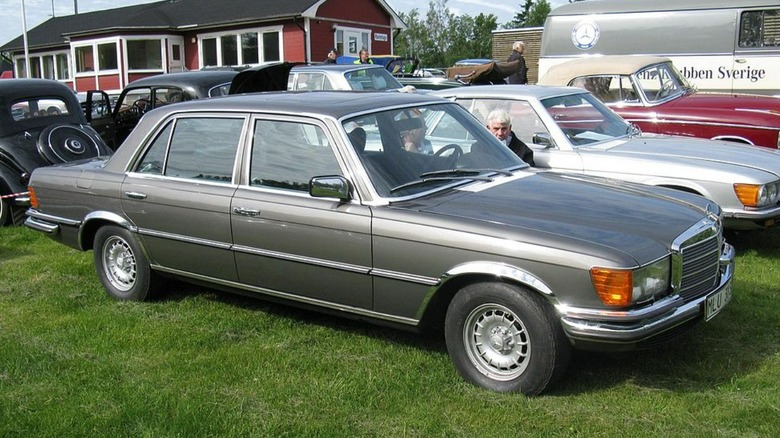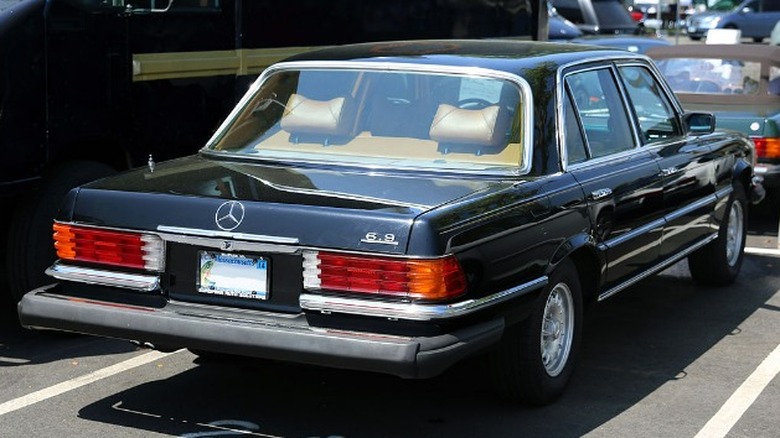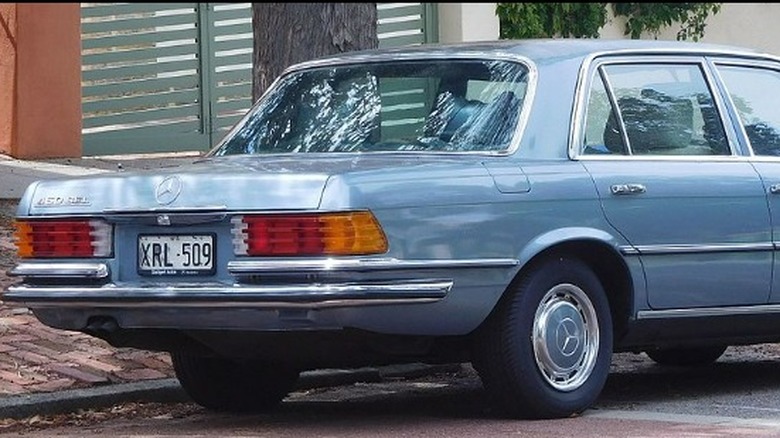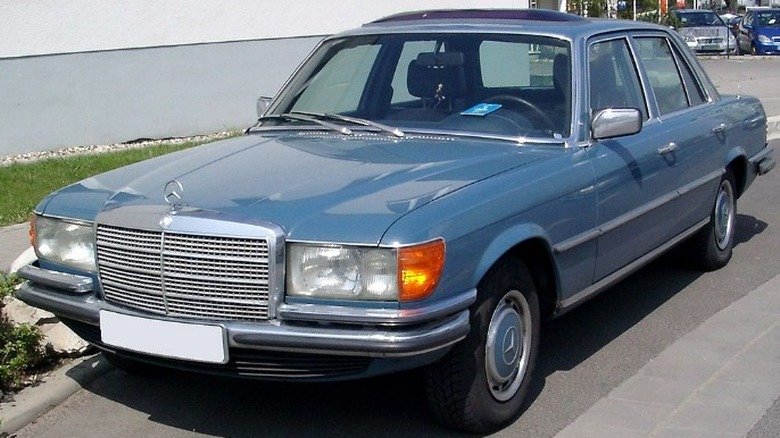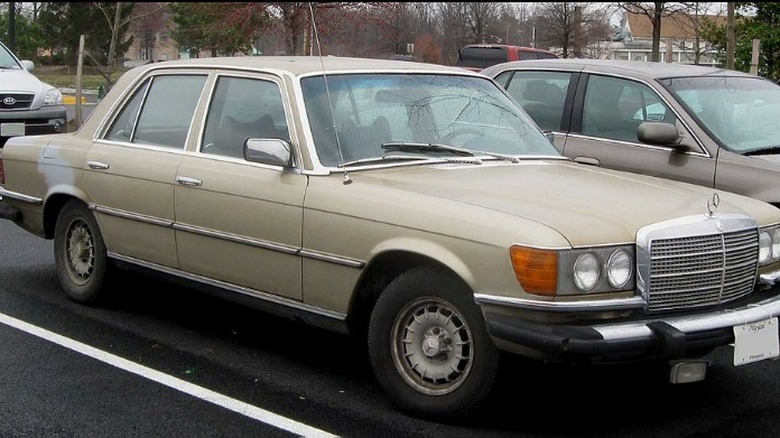The Mercedes That Took Luxury Cars To A Whole New Level
Mercedes-Benz is known for bringing high-quality automobiles to the marketplace. In modern times, the brand is pioneering autonomous driving technology, continuing to be a trendsetter and innovator. Mercedes has long been known for luxury, but this association wasn't always inherent to the American automotive audience.
The car that genuinely put Mercedes on the map was the 1972 450 SE (and its beefier 450 SEL offshoot) from the W116 series. This car was the first actual S-Class vehicle brought to the market, and its technological and stylistic underpinnings changed how other manufacturers developed their models for a generation. Road & Track wrote of the car in June 1973: "The Mercedes-Benz 450 SE is the best sedan in the world." Indeed, they were on to something with this analysis because the 450 SE and SEL models have stood the test of time as Mercedes' crowning achievement.
A key component to this Mercedes' success had to be the price tag. For a vehicle sporting so many nuanced upgrades and innovative features, the equivalent price of the 450 SE adjusted for inflation as of April 2022 is $88,243.65. Compared to the current Mercedes model, the S 500 listed at $111,100, the 450 SE offered a buyer excellent bargaining power. But the price isn't the only thing that has led to this vehicle becoming a standout for buyers in the '70s and car collectors in modernity.
The body style has become an icon
One of the primary features of the W116 series was its exterior dimensions. Offered in two configurations, buyers could drive home in the 450 SE or 450 SEL that elongated the wheelbase by 3.9 inches (up from 195 inches). In comparison to modern auto bodies, these cars look clunky and voluminous. The compartment is somewhat upright, and the hood utilizes an ever-so-slight taper that would look strange by today's standards.
Even so, in 1972, when the vehicle debuted in the American market, it created a shockwave in the automotive arena that quickly resulted in redesigns of American cars over the years that followed. By 1975, the Ford Granada, Cadillac Seville, and Mercury Monarch all harkened to the style set in motion by the 450 SE from '72. The somewhat boxy aesthetic and interior volume maximized for comfort continued to persist in auto stylings for the next two decades before another trend — streamlining — would come into play.
The 450 SE offered internal improvements, not just a highly sought-after visual style. The W116 series included crash safety features that made driving less hazardous. Alongside the revamped head and taillight positioning, this new Mercedes brought large bumpers into play and added body crumple zones that padded the impact for those riding in the vehicle. Mercedes initially toyed with this feature in 1959 but brought it to fruition in the W116. This innovation continues in modern cars and has been adopted across the board.
With ample power, this Mercedes could hum down the road
Mercedes had noticed sluggishness in other large vehicles of the era, so designers opted for substantial power to offset the heavy chassis when the company was piecing together the 450 SE and 450 SEL. In the standard 450 SE, drivers enjoyed a 4,520 cubic centimeter V8 engine that produced 220 horsepower and could achieve a top speed of 132 miles per hour.
The 450 SEL used the same engine but came with an optional upgrade to a 6.9L V8, substantially increasing the displacement (6,834 cubic centimeters) and improving the output to 286 horsepower. The 6.9L model enjoyed an improved top speed of 150 miles per hour. The 6.9L option benefitted from 406 foot-pounds of torque and a 0-60 time of 7.2 seconds. The SE offered 266 foot-pounds of torque and an acceleration time of 8.4 seconds.
"Ask for small throttle openings and the 6.9 surges proportionally forward. Demand more, and the pauses get larger, as the torque converter spins up and occasionally allows for a lower gear for even more acceleration," Antony Ingram writes for Hagerty. He also notes that the vehicle "creeps easily through traffic and hangs on the coattails of modern traffic without getting flustered." Even as a 50-year-old vehicle, the 450 SE and 450 SEL W116 models feel right at home as luxurious autos still to this day.
The retooled suspension made driving as smooth as butter
In addition to power output, Mercedes developed a completely new suspension system for absorbing the typical shocks of the road. With a self-leveling hydropneumatic strut in the 6.9L setup, the W116 improved stability, reducing the effort required to steer through turns and make minor corrections. For the other two models, Mercedes utilized a control-arm fixture in the front and swing axles in the rear. Both innovations were a class above the competition at the time, but for the 450s, Mercedes improved on already excellent designs.
The front end used an antiroll bar and lower wishbone installations, while the rear included semi-trailing arms for the first time. All this led to zero-offset steering countered by assisted internal steering systems that gave drivers the best of both worlds. Steering is "easy-going – it's not fingerlight, but requires little conscious effort to direct," Antony Ingram offers.
Luxe interiors were to be expected in this new line of elegance
Luxury was a prominent feature of such a magnificent vehicle. In the 450 SEL, leather upholstery came standard, and the SE model could be upgraded for $376. The SE and SEL models were listed at $13,491 and $14,698, respectively, and came loaded with virtually everything a driver could want. Unlike customization and upgrade options that can balloon a car's final price tag, this total cost included air conditioning, power steering, a radio (AM/FM) power windows, and a feature that would engage locking mechanisms throughout the car when the driver door was locked.
The dashboard and interior are each laid out to perfection. Mercedes vehicles take a similar approach to interior design as BMW's famously spartan appearance but don't follow to the same extreme. The control panel is grouped smartly and offers all the necessary information while driving without adding frivolous data points that only serve as sales points in a brochure.
Inside the vehicle, you experience the smoothness of the ride and controlled engine power (as well as a subdued but pleasant vibration and hum of the engine's output) without feeling them as a burden. The car is a marvel of Mercedes' ingenuity and truly put the manufacturer on the map for luxury.
